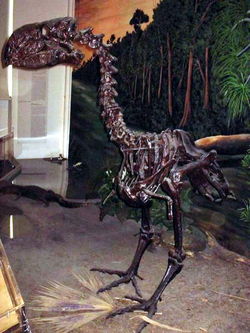Gastornithes
Fossil range:
Late Paleocene-Eocene
|

Gastornis fossil skeleton
|
|
Scientific classification |
| Kingdom: |
Animalia
|
| Phylum: |
Chordata
|
| Class: |
Aves
|
| Order: |
Anseriformes or
Gastornithiformes
|
| Family: |
Gastornithidae
Hébert,
1855 |
|
|
Genera |
- Gastornis
- Zhongyuanus
- Omorhamphus
|
Gastornis is an extinct
genus of large
flightless birds that lived during the late Paleocene
and Eocene periods of the Cenozoic. Gastornis lived in
Europe, but it had an extremely close relative in North
America; the North American bird is often called
Diatryma (DIE-a-TREE-ma), but experts now believe
they both belong in the Gastornis genus.
Gastornis measured on average 1.75m tall, while "Diatryma"
was 2m tall. It had a remarkably huge
beak, which may mean that it was carnivorous (although
the beak may simply have been used for sexual display and
probably was better suited for crushing than for tearing or
cutting action). Similar (but unrelated) gigantic birds were
the Phorusrhacoids with South American origin and the
Australian Dromornithidae (Genyornis). The former were certainly and the latter possibly
carnivorous.
The closest living relatives of Gastornis are the
Anseriformes, which includes waterfowl and screamers. In fact, gastornithids might well be
anseriforms themselves.
Gastornis's name means 'Gaston's bird'; it is
named after Gaston Planté, who discovered the first fossils
at Geiseltal, Germany.
Gastornis appeared in the
CGI series Walking with Beasts. It also made an appearance
in the 2006 CGI family film Ice Age: The Meltdown.
References
- Hébert, E. (1855): Note sur le tibia du Gastornis
parisiensis. C.R. Acad. Sc. Paris 40:
579-582. [Article in French]
External link




